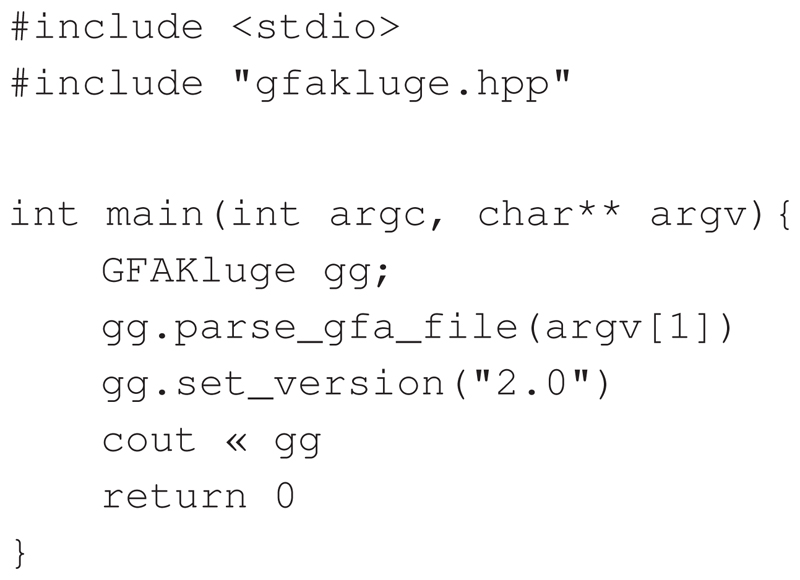Abstract
Summary
GFA has emerged as a standard format for the exchange of genome assemblies and sequence graphs. To encourage further adoption in high-performance software we have developed an open-source C++ library for GFA and a set of utilities for summarizing and manipulating the format.
Availability
The gfakluge source code is freely available under the MIT license at https://github.com/edawson/gfakluge. It has been tested on both Mac OS X and Linux.
Introduction
FASTA has remained the dominant file format for representing genome assemblies for several decades. While it is a standard for representing sets of sequences, FASTA provides little information beyond the contig sequences themselves. Almost all modern assembly software generates assemblies using some form of sequence graph (which we take as including de Bruijn and overlap graphs) [Zerbino and Birney (2008); Simpson et al. (2009); Simpson and Durbin (2010)], but conversion to FASTA loses information contained in the graph about possible joins between contigs, and other potentially useful information available to the assembler. Proposed graph-friendly formats such as ASQG [ref] and FASTG [ref] have seen limited adoption. Sequence graphs have also shown promise for read mapping [(Erik Garrison et al., vg: The variation graph toolkit)] and programs have emerged for visualizing graph structures for biological purposes [Wick et al. (2015)].
The GFA format was proposed to bring simple interoperability between programs for assembly, modification, and visualization while preserving the information in the assembly graph (Shaun Jackman et al. 2015, https://github.com/GFA-spec/GFA-spec). Parsers and format manipulators are available in ruby Gonnella and Kurtz (2016) and python (https://github.com/AlgoLab/pygfa), Diego Lobba, 2017), but the majority of assemblers are written in languages such as C or C++. Therefore where these programs read or write GFA they rely on hard-coded translators incorporated into their source code. This creates a substantial burden to supporting GFA, reducing the ease of modularising assembly code, and leads to many small incompatibilities between output files that can be difficult to debug. We developed gfakluge as a freely-available, open-source C++ library for reading, writing and manipulating GFA with the aim that it will encourage community uptake of the GFA format in high-performance software, and the development of interoperable suites of assembly software.
1. Features and methods
1.1. Requirements
gfakluge requires a C++-11 compatible compiler (e.g. gcc4.8 or newer). It does not have any external dependencies.
1.2. Parsing GFA files
gfakluge parses text from the original GFA proposal ("version 0.1") and both the GFA1 and GFA2 specifications. The parser generates a set of C++ map containers using string keys and struct values. Structs are defined for each of the line types defined in the GFA spec. The parser supports both SAM-style and JSON tags and can easily be extended to include new or custom lines.
1.3. Converting between formats
gfakluge provides a high-level interface for conversion between GFA versions. A header containing the VZ tag is encouraged when parsing if the input file is not GFA 1.0. Setting the GFAKluge object’s version before output is sufficient for converting formats if no modifications to the object’s structures are necessary. The internal structures of the graph can be converted to be compatible with GFA 1.0 / 2.0 using the gfa_1_ize() and gfa_2_ize() methods in the GFAKluge class. Conversion between the various formats is currently useful, as many programs are using disparate versions of GFA. As uptake of flexible parsers like GFAKluge becomes more common the importance of being able to convert between the GFA versions will wane, as more tools will begin to operate on the most up-to-date specification.
1.4. Integrating GFA parsing into a larger program
We used gfakluge to implement GFA parsing in the variation graph toolkit vg [Garrison et al. (2016)]. Reading a GFA file of any version requires two lines of code. Converting from vg’s internal representation to valid GFA requires 39 lines of code, the majority of which is spent filling in individual struct fields with members from vg’s graph class.
1.5. Command line utilities
gfakluge provides a number of useful utilities for modifying GFA files as they pass between programs. A gfa_stats program computes basic assembly and graph statistics such as the number of nodes and edges, the N50/N90/L50/L90, and total sequence length. The gfa_subset utility can extract a subset of a GFA graph between two nodes. There are also utilities for sorting a GFA file by source node or by grouping lines of the same type together and for modifying the identifiers of multiple graphs and merging them into one ID space.
Fig. 1.
A basic C++ program for converting a GFA1.0 or 2.0 file to GFA2.0, which shows the high-level interface for format conversion.
Acknowledgements
We would like to thank Shaun Jackman, Gene Myers, Jason Chin, Giorgio Gonnella and Heng Li for discussions about the GFA 1.0 and 2.0 formats.
Funding
ETD is supported by a Cambridge Trust - NIH Fellowship as part of the NIH Oxford Cambridge Scholars Program.
References
- Garrison E, et al. vg : the variation graph toolkit. 2016:1–31. [Google Scholar]
- Gonnella G, Kurtz S. RGFA : powerful and convenient handling of assembly graphs. 2016:1–9. doi: 10.7717/peerj.2681. [DOI] [PMC free article] [PubMed] [Google Scholar]
- Simpson JT, Durbin R. Efficient construction of an assembly string graph using the FM-index. Bioinformatics. 2010;26(12):367–373. doi: 10.1093/bioinformatics/btq217. [DOI] [PMC free article] [PubMed] [Google Scholar]
- Simpson JT, et al. ABySS : A parallel assembler for short read sequence data ABySS : A parallel assembler for short read sequence data. 2009:1117–1123. doi: 10.1101/gr.089532.108. [DOI] [PMC free article] [PubMed] [Google Scholar]
- Wick RR, et al. Bandage: Interactive visualization of de novo genome assemblies. Bioinformatics. 2015;31(20):3350–3352. doi: 10.1093/bioinformatics/btv383. [DOI] [PMC free article] [PubMed] [Google Scholar]
- Zerbino DR, Birney E. Velvet: Algorithms for de novo short read assembly using de Bruijn graphs. Genome Research. 2008;18(5):821–829. doi: 10.1101/gr.074492.107. [DOI] [PMC free article] [PubMed] [Google Scholar]



